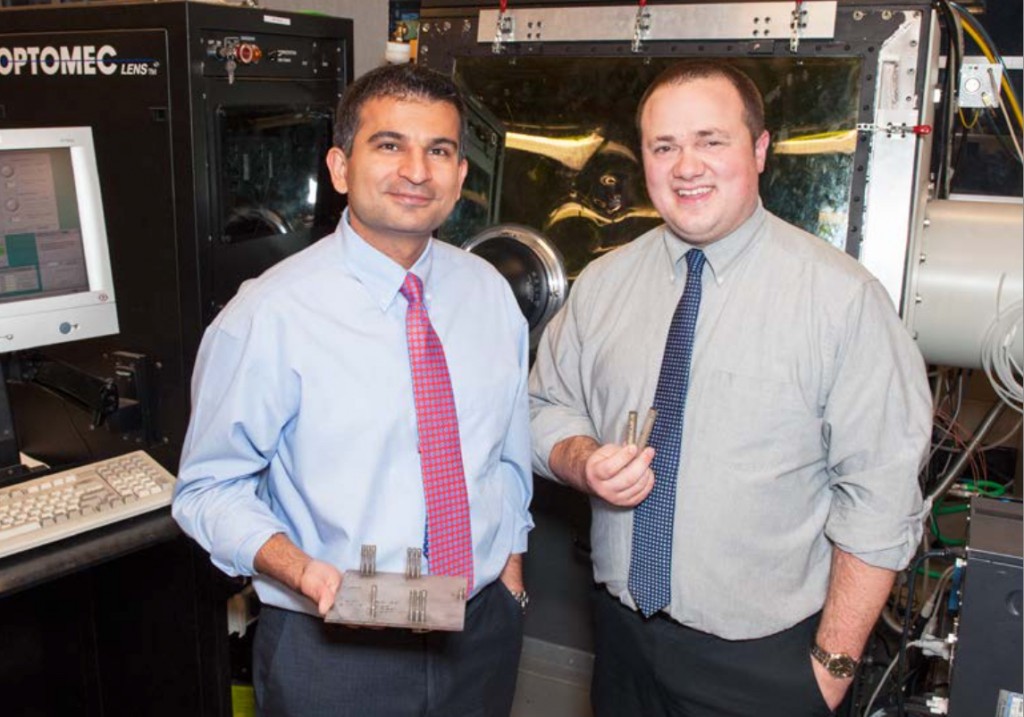Researchers Lab-to-Fab Work could Create U.S. Manufacturing Renaissance
March 24, 2015
 Lab-to-fab describes the work two CAVS researchers are conducting to help an emerging technology move from the laboratory to a production environment. Additive manufacturing (AM), more commonly known as 3-D printing, is mainly used to create three-dimensional prototypes from a digital blue print for engineers and designers. Researchers Scott Thompson and Nima Shamsaei are trying to discover a configuration for laser free-form technology, a type of AM process, to use metals to produce reliable parts for the automotive, aerospace and biomedical industries.
Lab-to-fab describes the work two CAVS researchers are conducting to help an emerging technology move from the laboratory to a production environment. Additive manufacturing (AM), more commonly known as 3-D printing, is mainly used to create three-dimensional prototypes from a digital blue print for engineers and designers. Researchers Scott Thompson and Nima Shamsaei are trying to discover a configuration for laser free-form technology, a type of AM process, to use metals to produce reliable parts for the automotive, aerospace and biomedical industries.
If successful, the two assistant mechanical engineering professors could help to create a manufacturing industry renaissance that makes it worth the investment for U.S. companies to build products here and sell them worldwide.
“This research of how to print reliable 3-D metal parts can be a favorable economic game changer for American manufacturers and workers,” Thompson said. “For instance a car dealer could download a digital file and have a customized part printed on-site, or if an airline mechanic needs a part to fix a plane it can be printed on-site rather than delaying the flight waiting on a part. It is cost effective in terms of not having to bulk manufacture the part, there are savings in inventory and shipping, plus you’re adding high-tech jobs,” Thompson said.
Looking long term, highly customized manufacturing is predicted to have a huge impact; industrial sales of AM products and services are forecast to exceed $6.5 billion by 2019. Experts’ conclude that the technique can be more cost-effective than traditional methods.
“Conventional—subtractive–manufacturing methods carve and remove material from a solid block to create a part. Additive manufacturing uses lasers that melt metal powders that shape a part from the bottom up by adding ultrathin layer upon ultrathin layer,” Shamsaei explained. “Our Laser Engineered Net Shaping (LENS) machine gives us the capability to fabricate complex geometries by adding layers with micro precision.”
One disadvantage of the LENS AM system is that it can fabricate parts with structural impurities, thus impacting the mechanical behavior of the parts. Thompson specializes in heat transfer and Shamsaei, a fatigue expert, clarified that the final product quality depends on the microstructural layering (the build—of the part), which depends on the thermal history.
“We can monitor temperature and control the process parameters to keep the temperature at the level we want for structural integrity. This helps us optimize process parameters for producing a reliable part for its intended application.” Shamsaei said.
Mississippi State University is one of only a few universities in the nation to install a state-of-the-art thermal imaging-system to help Shamsaei and Thompson monitor heat levels during LENS fabrication – helping them control the process and validate models. What is more unusual and unique is to have all this high-tech equipment including LENS as well as materials and fatigue characterization located under one roof. CAVS is one of the only research centers in the southeast to offer these kind of resources.
“There are these different variables you have to tell the machine—like how fast—there is a laser that comes down and then there is powder that is blown into the laser. How fast does the powder have to go into the laser? How fast does it have to move? There are all these print parameters, and they all have to be perfect to get the part that we can trust. So, I’m observing and modeling the thermal behavior and Dr. Shamsaei is characterizing the mechanical behavior and fatigue resistance of samples by strategically breaking them via tensile and fatigue tests. We then optimize those parameters to fabricate reliable products. Dr. Linkan Bian from Industrial and Systems Engineering is helping us with this process parameter optimization.”
The current Whitehouse administration has made a national commitment to support AM research by forming the National Network for Manufacturing Innovation Institute, located in Youngstown, Ohio. It is a regional network of research universities attracting industry partners located in the Northeast part of the country. However, the two Mississippi state researchers’ work in AM has caught the attention of several large, medium and small manufacturing companies, along with government and academic entities. Together they have formed the Consortium on Laser Freeform Fabrication of Engineered Products with Enhanced Structural Integrity (CLF2).
“We hope this initial ‘product driven’ group of more than 20 committed members led by Mississippi State will help contribute toward the AM national initiative by finding unique solutions. We want to help Mississippi become the hub in the southeast for advanced, high-tech manufacturing. And since MSU is the largest state university with the first and the largest engineering college, we should be able to support that mission,” concluded Thompson and Shamsaei.
